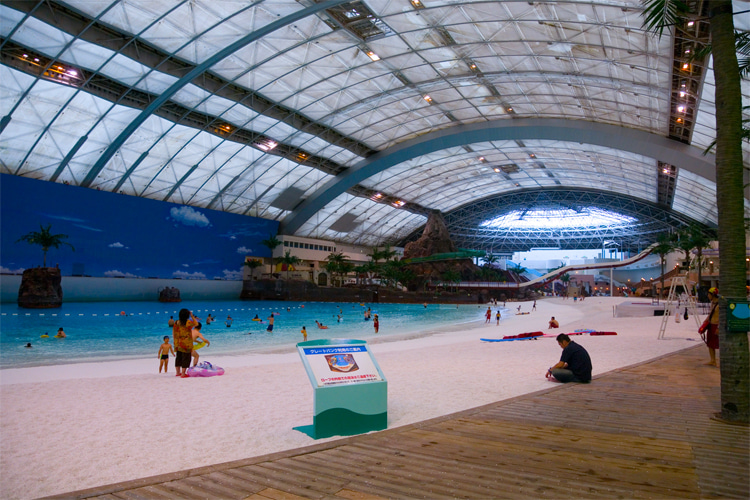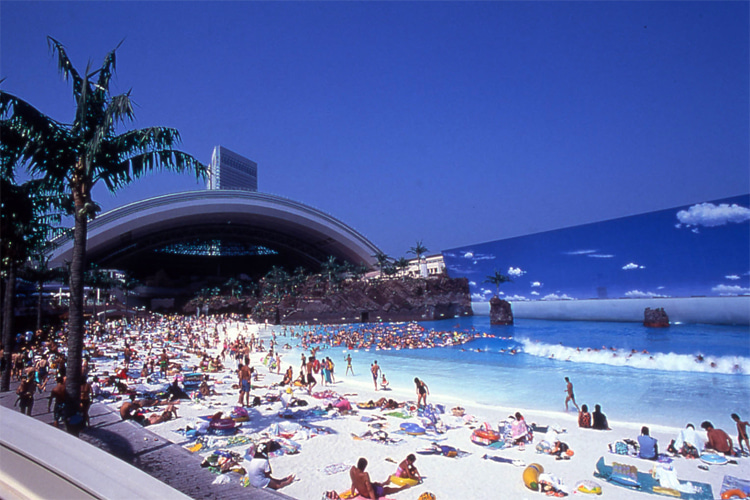The thing about Ocean Dome is that it was a real place. Miyazaki, Japan, 1993. Seagaia Resort opens its newest addition—Ocean Dome. 200 billion yen. An artificial beach, encased in a giant dome1 over 1000ft long. The world’s largest retractable roof, the world’s biggest simulated pool, a 13,500-ton ‘ocean’ of unsalted, chlorinated water, a wave machine that created surfable waves. The Dome was heated to 30°C, with fake palm trees hiding speakers that played ‘island-themed’ music. The walls were painted to look like the sky2, and the lights could mimic a day/night cycle. “This is a place where we can feel that we are part of nature,” said Phoenix Resorts.3
From the article, ‘Ocean Dome: The Most Artificial Place on Earth?’ written by David Boyle for the Ecologist Magazine in October 2003:
“It was a beautiful summer’s day outside, but the great dome above the beach stayed resolutely shut for fear that the real world would tempt us away.
I watched an elderly lady paddling and a couple of youngsters dashing in and out of the precisely regulated waves, and tried to pinpoint exactly why the whole thing was disconcerting.”
The thing about Ocean Dome is that when I visited, it was almost full. Opening year, the Dome is busy and alive, the ceiling a huge constant mouth, air almost steam-like. The walk inside quickly transitions from carpark to sand, as the doors shut behind you and the Dome reveals itself in wonder. The sand is a brilliant white, that ‘Americans are obsessed with teeth’4 white, ocean so blue you second-guess yourself as to ever having seen blue before, and perhaps it would feel more real if the miniature volcano to your right didn’t have a waterslide wrapping around it. You’ve never been one for beaches, especially not busy ones, but this feels different. Private almost, despite the hundreds of people. You go on a log flume. A lazy river. You sit on a beach chair sipping a sugary, fruity juice, listening to music that could be out of Wii Sports Resort5, over two decades later, when the sky opens above you. A loud whirr of motors and the roof begins to part, and you’re dazzled by the feeling of real sunlight, the brightness of it all, the endless blue that makes the walls flat by comparison, because they are flat, they’re paint and peeling but you can see the sky, and it’s so dizzying that you want to vomit.
“It was pleasantly warm, but it felt faintly like a gymnasium—and they always remind me of exams. Also, the palm trees were too perfect to be real. Some fruit on display turned out to be plastic, and the beach’s backdrop was painted with small clouds and a deep blue sky as the Pacific view outside probably should have been.”
The thing about Ocean Dome is that the next time you visit, it isn’t for almost 10 years. Gone are the opening hype crowds, replaced by a tourist or two. A couple of bored teenagers clearly here since the tickets are cheap. The staff seem almost relieved to see you, as they’re relegated to their stations, such as the guy stuck in the circular tiki-themed wooden bar, which turns out to be made of something closer to foam or plastic. He puts one of those little umbrellas6 in your drink.
The thing about Ocean Dome is that it’s quiet now, and you can hear just how tinny the music is through the speakers. Curious, you place your brightly coloured drink down onto the sand, and press an ear against one of the ‘trees’—they’re made of the same plasticky foam—and inside you can hear the music, bleating like a newborn lamb, winding down like an old toy, the same downturn on a particular moment of the song, almost as if its batteries are running low.
“There was something fascinating about Ocean Dome, but something unnerving too. I suppose it’s the fear in the back of the mind that this may soon be the only kind of beach we’ve got left—the rest having been abandoned and turned into chemical jetties or oil slicks.”
The thing about Ocean Dome is that it feels smaller now. Before, in the crush of people, the Dome felt endless, like at some point the walls would melt away and you would realise that it was supposed to have ended a mile ago, but now, empty, same sand, same flat blue walls, it’s the same size as your primary school hall, the one that feels swallowing as a kid, and oppressive as an adult. You wander for a bit. The volcano is made of that same foam, the fruit lining the bars, the rocks. You slip into what used to be a ride of some kind, a dark theme park tunnel, and the cold from the shadows is relieving. They removed the karts that would go through here, you can see the tracks where they would have run, allowing you to walk through instead. It was presumably a cost-cutting measure and a means for less maintenance, less staff. It’s hard to see what exactly you were supposed to be looking at in here. Endless foam walls, a singular tram-esque line down the middle. You wonder if this is what Cuba Street’s tram lines looked like in the 1960s7. You’re not so much walking with a destination, as you wouldn’t be here at all if that was your goal, but more of a tame curiosity, a laissez-faire, lazy Sunday kind of curiosity. You wind through tunnels that seem to loop back on themselves, confuse you, until finally, you begin to see some light again.
“And I realised that this is exactly what we have been told throughout my life—either by those who were excited about this brave new artificial future, or by those who felt powerless to stop it.
We have lived through more than half a century of being constantly told that the future of food was artificial, the future of books, newspapers, medicine and schools was virtual. And that we would soon deal entirely with computerised teachers and doctors through the internet.”
The thing about Ocean Dome is that it doesn’t look as impressive from up here. The tunnel has opened up to the top of a ‘hill,’ much more mini golf in nature than dirt, and the brightness once again makes you blink fervently, ocean coming back into view with gentle waves lapping at the shore, volcano not miles across the bay, but almost looking as if it was within arm’s reach. The few other visitors look like dolls from up here, like Polly Pockets8 maybe, like you could reach out to scoop them up to place them back in your playhouse that you once managed to trap a spider in, (daddy long legs)9 watching it curiously for days before being told that little girls shouldn’t do things like that, let it go in the garden only for its corpse to blow away, legs folded in on themselves like a delicate cage—
“Many of the technologies predicted over the past half century have come true, of course, but they haven’t sent reality packing as we were led to expect.”10
The thing about Ocean Dome is that it isn’t supposed to exist anymore. It was closed in 2007 and demolished in 2017. But it’s warm in there, enclosed, and I think about a womb if a womb was a swimming pool. And I think about the way your skin looks, sweaty, sweaty, sweaty. And hair flat to your forehead like when you sleep on your stomach and your fringe is sticking straight up in the morning, so you dip your head down under the bathroom tap and use sleep-addled fingers to smooth it down. The Dome is so wide you can’t see the ends, wider, it’s realer than real, it’s what real should be, controlled and cradled and curated.
And the thing about Ocean Dome is that since it doesn’t exist anymore I can say anything I want about it and you will believe me. And it doesn’t exist and it never existed and it will exist always, and Ocean Dome lives within me, within girls changing rooms at the pool where I tried desperately to create a wall with my towel and was fascinated by the slightly damp ridged tiles under my toes, and that green spot by the drain, and that crinkle of plastic in the bathroom isn’t mine because I’m not a person and I don’t exist anyway,
And the thing about Ocean Dome is that no matter how perfect it was inside my head I will never be there, and it definitely had a set of girls’ changing rooms because nothing is gender neutral in 1993, and I don’t exist in 1993, only my mother does, and she is 11 with braces in Aotearoa.
And the thing about Ocean Dome is that it is basically the ship from Wall-E11, except Wall-E is real and was supposed to be hyperbolic and I don’t even go in the ocean.
And the thing about Ocean Dome is that its circumference is the year I was born plus the miles it would take to get to Japan, a place I’ve always wanted to visit but never have.
And Ocean Dome is as big as 10 ocean liners, not that I know what that means since I’ve never been on a cruise ship and I get motion sick so easily.
My friend always says he never knows what I want; that I always seem unbothered. But I’m always wanting, wanting, wanting until it makes me want to scream.
I hated sports as a kid because I always had to be on the girl’s team but that never happened when we played soccer at lunch, when it was just me and the boys and I’m included in the boys and they’re fearless; unlike the Sunday morning girls—afraid of the ball.
I can’t write about you yet. It hasn’t been long enough. It never will be. And there’s so many yous. Dozens.
I want to be just like David Byrne12. I say that’s why I wear my huge coat; with the buttons on one side, and not because I shop second-hand, and I don’t know how to fit a coat to what my mother says are my broad shoulders
And I don’t know how to tell my best friend that I will miss her excruciatingly
How selfish I want to be and tell her not to go. Huge lump in my throat and I know—
Lump the same size as those little treats we would always buy together. Our matching mochas and cinnamon rolls or eggs or pasta orders sticking to my tongue.
Instead of her moving I’ll just Weekend at Bernie’s13 her boyfriend. Oh sorry babe, you wanted alone time? What if we had a threesome instead?
Sorry, I can’t stop talking. And sorry I didn’t write longer poems. Didn’t submit them, didn’t edit them, that I can’t say what I want to say without resorting to metaphor and cannibalism and teeth, and—
The thing about Ocean Dome is that it’s me. In that even though I look like an ocean I’m not one. In that in 2003 David Boyle presented a throwaway article on a funny little amusement park. In that he questioned the nature of our existence and whether our futures would look so Ocean Dome-like, virtual, virtual teachers and doctors and friends. In that when I think about authenticity I think about the way I scramble to present myself when a camera is brought out, only to look at the picture and double-take at the face of the being within, one carried through sports games and girls locker rooms, gynaecologists and ‘women’s spaces,’ expecting to see the ocean and becoming nauseous at the sight of a Dome instead.
It stares back at me. Through me. The Dome beckons, and begs me to frolic in long-demolished waters. Is my Dome condemned, too?

- More of an oblong, or a loaf. ↩︎
- See The Truman Show. ↩︎
- David Boyle, Authenticity (Harper Perennial, 2004) ↩︎
- You know, how Americans always have to have teeth whiter than white? ↩︎
- Nintendo, 2009. ↩︎
- Cocktail umbrellas. The kind your partner always tries to save and place behind his ear. ↩︎
- Cuba Street’s trams were removed in 1964. ↩︎
- The ones from the early 2000s, with magnetic or rubber clothes you would always chew on. ↩︎
- Pholcus phalangioides. ↩︎
- David Boyle, October 2003. ↩︎
- 2008. ↩︎
- The founding member of the Talking Heads. ↩︎
- 1989. ↩︎
Featured photos via Surfer Today.



